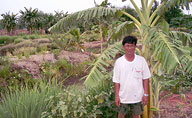EcoTipping Points
- How do they work?
- Leveraging vicious
cycles to virtuous - Ingredients for success
- Create your own
EcoTipping Points!
Stories by Region
- USA-Canada
- Latin America
- Europe
- Middle East
- South Asia
- Southeast Asia
- East Asia
- Africa
- Oceania-Australia
Stories by Topic
- Agriculture
- Business
- Education
- Energy
- Fisheries
- Forests
- Public Health
- Urban Ecosystems
- Water and Watersheds
Short Videos
- Saving a Coral Reef and Fishery (Apo Island, Philippines)
- Community Gardens Reverse Urban Decay (NYC, USA)
- Community Forests Reverse Tropical Deforestation (Thailand)
- Escaping the Pesticide Trap (India)
- Rainwater Harvesting and Groundwater Replenishment (Rajasthan, India)
How Success Works:
- Saving a Coral Reef and Fishery (Apo Island, Philippines)
- Community Gardens Reverse Urban Decay (NYC, USA)
- Community Forests Reverse Tropical Deforestation (Thailand)
- Escaping the Pesticide Trap (India)
- Rainwater Harvesting and Groundwater Replenishment (Rajasthan, India)

Human Ecology:
Principles underlying
EcoTipping Points
Understand the Mission of The EcoTipping Points Project
Our mission is to develop and disseminate basic principles and practical applications of EcoTipping Points.
Concrete Objectives:
- Refine the EcoTipping Points paradigm and its basic principles, explaining how EcoTipping Points work and how they can be applied.
- Develop a procedural toolkit for people to create EcoTipping Points in their own communities.
- Disseminate EcoTipping Point principles and procedures through a variety of media.
- Collaborate to assist people who want to put EcoTipping Points into action.
The Ecotipping Points Project
Most of us are seriously concerned about the current and future impacts of environmental problems on our lives. We want to do something but feel overwhelmed by the scale and complexity of the problems and the powerful social forces that are driving them. EcoTipping Points provide a lens for making sense of the complexity in a way that points to effective action.
The EcoTipping Points project began in January, 2004, when human ecologist (Gerry Marten) and journalist Steve Brooks were brainstorming how to communicate principles of sustainable human-environment interaction. Gerry had already presented the principles in his textbook Human Ecology: Basic Concepts for Sustainable Development and now wanted to convey them to a broader audience. Gerry and Steve concluded that “tipping points” embrace many of the most important principles, showing how people can turn environmental decline around to restoration.
To explore how this new perspective would hold up in the real world, journalist Amanda Suutari compiled nearly a hundred environmental success stories. The stories span a diversity of ecosystems, cultural and socio-economic contexts, and environmental problems from around the world. And every story seems to have a tipping point. We conducted site visits to document about twenty of the stories in greater depth, using the EcoTipping Point paradigm to extract lessons that can inspire and guide everyone’s efforts to achieve sustainability.”
Details of this script translate into basic principles for how EcoTipping Points work. They also provide what we need for a toolkit to put EcoTipping Points into action.
We want to pass on what we’ve learned to anyone who can benefit: environmental professionals, government officials, educators, students, businessmen, community groups. To start, we put together a PowerPoint presentation that we use to explain EcoTipping Points to professional and community groups. We’ve also begun to publish articles in professional journals and popular magazines. The following have already appeared in print:
- Eco Tipping Points (Our Planet). Community mangrove management not only saves mangrove forests but also restores coastal fisheries and people’s livelihoods.
- EcoTipping Points: A new slant on strategic environmentalism (WorldWatch Magazine). We highly recommend this article to get an overview of what EcoTipping Points are all about.
- EcoTipping Points: A new paradigm for restoring ecological security (Journal of Policy Studies). The story of how EcoTipping Points began.
- Getting Clean: Recovering from pesticide addiction (The Ecologist). An inspiring EcoTipping Point story about how Indian cotton farmers escaped from a pesticide hell.
- Eco Tipping Points: How a Vicious Cycle can become Virtuous (Earth Island Journal). How a vicious cycle can become virtuous. Coastal communities in southern Thailand and Northern California make full use of nature’s free services.
To reach professionals, we organized an EcoTipping Points symposium at the annual conference of the Society for Human Ecology. We’ve also gotten a start at incorporating EcoTipping Points into K-12 education. Under the auspices of the North Carolina Center for the Advancement of Teaching, we conducted a week-long workshop for teachers to explore how EcoTipping Points can serve them. Several teachers decided to write a series of mini-books for classroom use, from elementary school to high school. Five elementary school mini-books have already been completed.
Now we’re looking for individuals or groups – community, government, education, business – who want to work with us on applying EcoTipping Points to their own situation. It’s an opportunity to start dealing effectively with environmental problems in your community, while helping to refine the EcoTipping Points toolkit and its dissemination for broader use. We are also looking for teachers who want to work with us to field test EcoTipping Points teaching materials in their classrooms.
Contact us if you would like to work with us or make a contribution.

